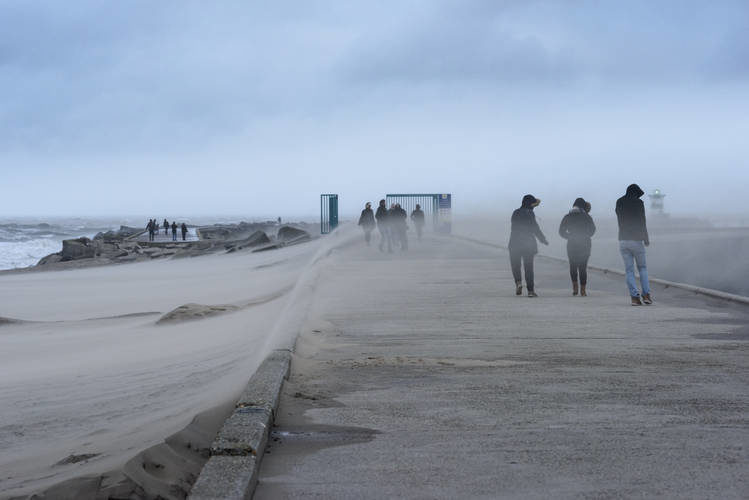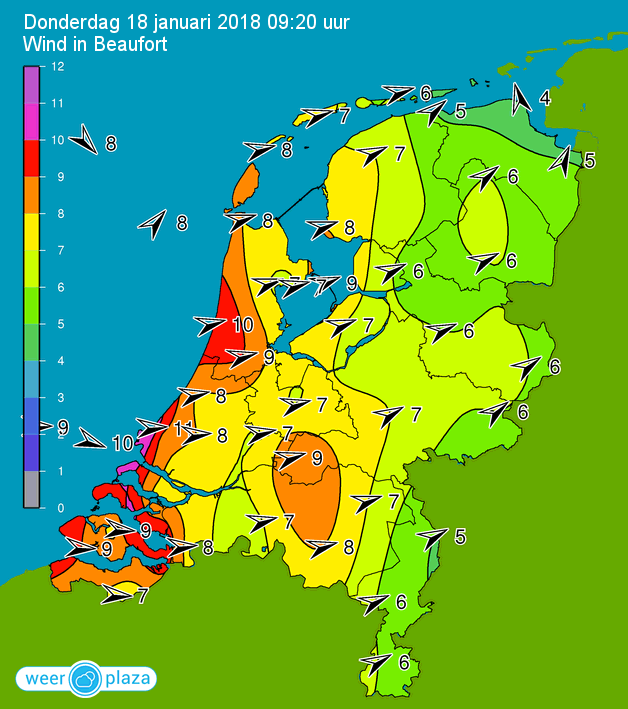
It also led to high water levels, which moved the Dutch infrastructure agency, Rijkswaterstaat, to simultaneously close all five flood barriers for the first time in history. These storm surge barriers are:
- The Maeslantkering, a flood barrier on the Nieuwe Waterweg, which closes if the city of Rotterdam is threatened by floods.
- The Hartelkering, another barrier which lies in the city of Spijkenisse. The last time this gate was closed, was in November 8th, 2007, after a storm hit the Dutch coast.
- The five-mile-long Oosterscheldekering in the province Zeeland, south-west of the country.
- The Hollandsche IJsselkering in the province Zuid-Holland, near the city of Rotterdam.
- The Balgstuw Ramspol, an inflatable rubber dam, which lies between the lakes Ketelmeer and the Zwarte Meer, in the province of Flevoland.
As Rijkswaterstaat tweeted on January 3rd, 2018: "Unique: All our five major storm gates are closing today! That has never happened before. The Maeslantkering and the Hartelkering are the two last gates that will be closed due to the storm and high water levels."
For several hours, wind gusts of approximately 55-63 mph (89-102 km/h) or 'wind force 10' on the Beaufort scale hit the northern Dutch island Vlieland. The strong storm on January 3rd, 2018, was the tenth strongest storm of this century, according to the KNMI. The strongest wind gusts were measured in Vlissingen, 87.6 mph (141 km/h), and Herwijnen, 75.8 mph (122 km/h).
Today, a code orange and a code red weather warning was issued as another storm has made its way to the Netherlands (and Germany), causing wind gusts of up to 80.7 mph (130 km/h) or 'wind force 10', especially along the Dutch coast in the early morning hours, according to Weerplaza. At least three people in the East of the country have been killed due to the storm, and public transport has come to a halt as fallen trees are blocking the rails.
In Den Bosch in the South of the country, wind gusts were so strong that they literally blew people down the street:
Trees were also blown down, giving some Dutch citizens a close call:
High-sided trucks also didn't fare well in the gale force winds (in Germany):
Heavy shipping containers at Rotterdam port were also no match for the gusts:
And a portable toilet was, of course, like a leaf in the wind (hopefully no one was inside)
Storms and other extreme climatic and environmental events are likely to become more frequent and more destructive due to the 'Earth Changes' that our planet seems to be undergoing right now. For more information on extreme weather from around the world, check out Sott.net's Earth Change Summaries.




Reader Comments
R.C.
P.S., Bezel Bub
I only this week, in re-reading Macbeth, learned the origin of that phrase, 'Something wicked this way comes'. (One of the witches says it as Macbeth approaches.)
RC
(1) This was the TENTH strongest storm since the year 2000.
(2) Never before have they had to close ALL their storm barriers.
What this means of course is that sea levels are steadily rising. And if you hear a loud braying noise, that is all the Republicans in the Capitol Building in Washington, DC loudly denying that climate change is happening, joined by Donald Trump who can bray louder than anybody. And if you hear a deafening silence, that is all the Republicans in the US Congress NOT beating down the doors of real estate agents to buy beachfront property in Florida.
And if you smell a particularly foul odor, that is the smell of hypocrisy emanating from Capitol Hill.
But WHAT are the real causes? What do we know? Is humanity's focus on that. Nope, but it will shift, it has begun.. Because there is a pattern. Oh yes, wait, many patterns, all acting as a crystal ball. My newfound moto is - The futur is climatic! ..or will be for sure.
For us and a few generations of survivors to come, climate (change) will be the ultimate force to reckon with. Has been alot like that on good old Mother Earth anyway.
LKJ once said I think : (paraphrasing here..) Do we need wars to cover climate change or do we use climate change to cover wars? For me this is a great question. Because thats where light is leaking the most and where the trail is easy to pick up!
If knowledge is power then climate knowledge is absolute power. Climate change (it's understanding) is the ultimate knowledge and the most top-secret topic for the elite and their pawns.
This is not to say that extreme weather does not naturally occur, even catastrophism is 'natural', because we have records of its occurring in the records of nature and of our ancestors. But the development of technology brings leverage of 'power', that creates instabilities demanding more power to manage them, and so on. Because we can and do mess up our own mind/nest/family/society/world we carry the guilt-imprinting that writes us into its narrative - particularly when seeking to manipulate rather than communicate.
While I would not be surprised if weather tech was used for a variety of experimental tools for peace or more likely weapons of war I remain open to Climate being an expression of the total charge state. One can see our experience of life in the universe as an embodiment or expression of charge relations also known as plasma cosmology or the electric universe idea. Even the screen of consciousness is one with (not separated from) the interplay of forces within us.
In some sense I also see the dammed up forces of suppressed and denied life turning malignant and leaking out in 'crazy ways'. A storm clears the air in more ways than one. But destructive forces may be the result of becoming extremely unbalanced and also develop or attract the unbalanced to seek out and wield the destructive - as if to gain power to maintain their imbalance.
So I maintain a sense that balance is extended from within and not enforced from a presumed 'without'.
The naming of storms is part of making us weather sensitive in terms of threat. Name magic is very old magic.